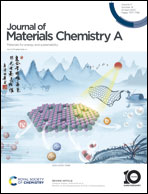Textile-based piezocatalytic platform for organics degradation under low-frequency water flow†
Abstract
Piezocatalysis has been regarded as a promising route for degrading organic pollutants in aqueous systems. Despite many successes in the lab, the practical application of piezocatalytic water treatment is greatly hindered by its strong reliance on ultrasonic waves, which necessitates dramatic energy input for operation. Piezocatalysis driven by the striking of low-frequency water flow has long been pursued. However, the stress provided by macroscopic water striking is ∼2 orders lower than ultrasonic cavitation, leading to far inferior piezocatalytic efficiency. Herein, textiles have been introduced as the substrates for piezocatalytic platforms. The highly curved, intertwined and mesoporous structure of textiles provides abundant stress concentration sites, which greatly amplified the striking force by ∼25.12 times at maximum, according to the mechanical simulation results. Besides, the high surface area and porosity of textiles accelerated the reactions and diffusion of reactants, which also favored piezocatalysis. A proof-of-concept piezocatalytic textile with molybdenum disulfide (MoS2) nanoflakes supported on a knitted fabric degraded 97.3% Rhodamine B (RhB) pollutant within 30 minutes with gentle vibration by an orbital shaker at 240 rpm, which is superior to the other state-of-the-art non-ultrasonic-driven piezocatalytic platforms. Getting rid of the reliance on ultrasonic waves, the piezocatalytic textile designed in this work greatly promotes the application of piezocatalysis in practical natural water treatment.

- This article is part of the themed collection: #MyFirstJMCA


 Please wait while we load your content...
Please wait while we load your content...